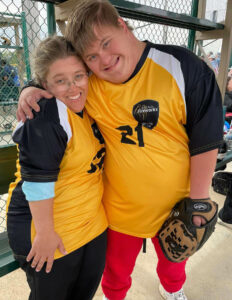Athlete Information
Sports & Competitions
 A key feature of Special Olympics South Dakota is a series of athletic competitions patterned after the World Olympics. Held year-round, they are:
A key feature of Special Olympics South Dakota is a series of athletic competitions patterned after the World Olympics. Held year-round, they are:
- Fall Classic (Bocce / Softball) (September)
- Area Bowling (October)
- State Traditional Bowling Tournament (November)
- State Unified Bowling Tournament (November)
- State Winter Games (February)
- Area Basketball Tournaments (February)
- State Basketball Tournament (March)
- Area Spring Games (April)
- State Summer Games (May)
- State Equestrian Competition (July)
In addition to the athletic competition, each of the games include all of the pageantry and excitement of the Olympic Games with events such as Opening Ceremony, Lighting the Special Olympics Flame of Hope, Victory Dances, Banquets, and Award Ceremonies.
Official and Developmental Sports Offered By Special Olympics South Dakota:
 Official
Official
- Athletics (Track and Field)
- Basketball
- Bowling
- Equestrian
- Football (Soccer)
- Power lifting
- Snowshoeing
- Softball
- Swimming
- Volleyball
- Winter Games
Special Olympics is unique in that it accommodates competitors at all ability levels by assigning them to competition divisions based on previous performances or preliminary heats. In this way, all athletes get a chance to compete against others of equal ability.
Additional Information
- We follow the National Governing Body rules of each sport.
- Athletes train prior to competition.
- Qualified coaches train participants.
- Sports are adapted to allow athletes of all ability levels to participate.
- Athletes compete in divisions made up of individuals with equal ability levels. (typically no less than 3 and never more than 8)
Step 1: Athletes are divided by gender. Female athletes compete against other female athletes and male athletes against other male athletes. When a relay team consists of both male and female athletes, the team is considered a “male” team and competes in a male division.
Step 2: Athletes are then divided by age. This is an athletes age on the opening date of the competition. Age Groups: 8-11, 12-15, 16-21, 22-29, 30+
Step 3: To complete the division process, athletes are then divided by ability. In some instances age groups need to be broadened. In those cases, athletes within the new age groups will be re-ranked and grouped into divisions. This process must be repeated until the highest and lowest scores within each division are as similar as possible
- All participants receive an award.
- Athletes and family members are not charged a fee to participate.
- Athletes who meet specified training requirements are eligible for Local, Area, and State Games.
- World Games are held every two years on odd years with Winter Games and Summer Games alternating. Competitors from the United States participate as part of Special Olympics USA.
- National Games are conducted every four years on even numbered years.
- Athletes eligible for National and World Games must complete an application and are chosen by a random draw.













